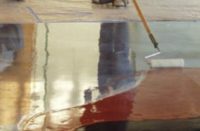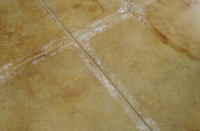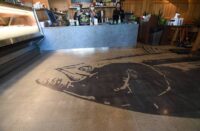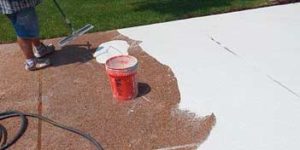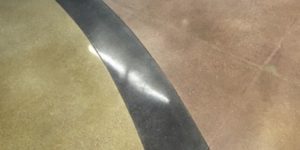Surface preparation is a commonly used term in the decorative concrete industry. An argument can be made that it might even just be the most used term in the industry. We hear or read about it most often when dealing with overlays and stains. Grind, scarify, acid etch, etc. These processes “open” and clean the substrate to allow the new topping or coloring to properly penetrate and adhere. The process of surface preparation is hands down the most important part of any topping or stain application.
Nothing really new there, so why am I rehashing old info that most everyone has heard hundreds of times? The answer is simple. While surface preparation is arguably the most common process, it is also the most misunderstood and improperly performed.
To be more specific, let’s look at one area of decorative concrete in which surface preparation is ultracritical but often overlooked or just brushed over — sealing.
Very few decorative projects do not use sealers or clear coatings of some type. In many cases the sealer is what really finishes the project, bringing out the true color, enhancing variations and providing that often-desired “wet look.” Not to mention the sealer’s true function — providing a layer of protection that greatly extends the life span of the project.
If sealers are so important and the industry promotes proper application, why do we see so many failures? I believe the answer lies in surface preparation or the lack thereof. Remember, sealers require a porous surface so they can penetrate, which in the end leads to proper adhesion. Without penetration, you don’t get adhesion, and that leads to sealer failure.
Let’s take a detailed look at some common sealer uses within the decorative industry to see where lack of sealer surface preparation breaks down and leads to problems.
Stamped surface prep problems
When it comes to stamped or imprinted concrete or overlays, typical surface preparation is to power-wash the surface, nothing more. While power washing does clean the concrete, it is often not enough. The analogy I often use is washing your hands. If your hands are dirty, washing with water gets some of the dirt off, but washing with soap and water gets all the dirt off. The same goes for preparing concrete and overlay surfaces that have been stamped. Whether powder release or liquid release is used, a good, quality soap-and-water scrub makes a huge difference. This is especially true when powder release is used, as powder release does not break down in water alone and needs the surfactants in soap to loosen up the residue and get it off the substrate. Don’t forget the scrubbing part, as soap alone is good, but the scrubbing action loosens excess chemical residue and is better.
All those concrete pores need to be clean to give the sealer a place to adhere to. If they are filled with powder, dirt, chemicals, water or whatever, the sealer sits up on the surface and is weak.
The second place we see surface preparation issues when sealing stamped work is when a secondary colorant or highlighting tint is used. It’s human nature to think that if a little is good, a lot is better. That mentality leads to problems when applying these secondary colors, as the color ends up in the pores of the concrete, and as stated above, if the sealer can’t get into those pores, you end up with sealer failure. Too often I see a stamped concrete slab that has been properly prepared for sealing, but because the highlighting color was applied too heavy, the project suffers from sealer failure six to 12 months after installation. Sealers can’t tell the difference between highlighting colors and contamination.
Stained surface prep issues
The other major decorative concrete sealer job that suffers from inadequate or improper surface preparation is sealing stained surfaces. The basic act of staining goes against everything sealer preparation is all about – a clean and contamination-free surface. When stains or dyes are applied, we are reducing the ability of a sealer to penetrate and adhere to the concrete.
The good news is that when applied properly and in the right (small) amounts, there is enough room for both stain and sealer to coexist and perform.
There are three key surface preparation factors to consider before sealing any stained or dyed surface:
1. Surface tension or tightness. With the growth in popularity of polished concrete, I am seeing more diamond grinding and polishing machines used to prepare surfaces for staining and sealing. The problem is less with the equipment and more with the diamonds pads being used. Even the low-grit (20-grit to 100-grit) metal-based diamond pads are designed to start honing concrete, not open or rough the surface. Applicators think they are preparing the surface, while in actuality they are tightening or honing the surface, leading to sealers’ inability to penetrate and adhere.
2. Overapplication of the stain. This is more of an issue with new-generation water-based stains, as they don’t have the penetrating depth of solvent-based or reactive stains. Space within the concrete substrate is at a premium. The stain and sealer need to share that space. If the stain is overapplied, it leaves no room for the sealer, which in turn leads to sealer failure. Applying these types of stains lightly is very important. Cleaning any and all excess stain residue from the surface is critical. Don’t be afraid to use soap and to get a little aggressive with scrubbers when preparing stained surfaces for sealers.
3. The pH level. The pH scale measures acidity and alkalinity on a scale of 1 to 14. Water is neutral (7.2), and concrete is alkaline (12). When any pH-altering chemical (such as acid stain, sealer stripper or acid-etch material) is used on concrete, the surface must be neutralized. This involves cleaning the surface with alkaine soap and a good clean water rinse. If the surface is not neutralized, the chemistry of the sealer is compromised, resulting in sealer failure.
No matter the sealer type or decorative concrete finish, properly preparing the concrete prior to sealing is critical to long-term success. Don’t fall victim to rushing the last step – sealing – of your decorative concrete project. Take the time to understand what a properly prepared surface looks like and how to get there, and success will follow.
